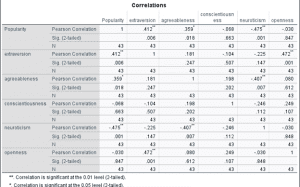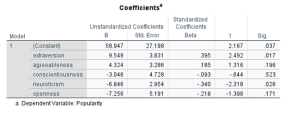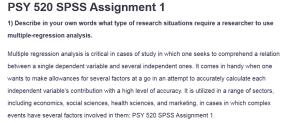PSY 520 SPSS Assignment 1
1) Describe in your own words what type of research situations require a researcher to use multiple-regression analysis.
Multiple regression analysis is critical in cases of study in which one seeks to comprehend a relation between a single dependent variable and several independent ones. It comes in handy when one wants to make allowances for several factors at a go in an attempt to accurately calculate each independent variable’s contribution with a high level of accuracy. It is utilized in a range of sectors, including economics, social sciences, health sciences, and marketing, in cases in which complex events have several factors involved in them: PSY 520 SPSS Assignment 1.
For example, it can be utilized in predicting the behavior of a consumer with regard to demographics, price, and advertisement or in investigating the impact of socioeconomic factors on a state of health. With the use of a multiple-regression analysis, one can account for and extract the confounding variable’s impact, make a prediction with a high level of accuracy, and make a decision with a high level of accuracy, basing it on strong, overall models.
2a) Run a basic correlation matrix for the popularity, extraversion, agreeableness, conscientiousness, neuroticism, and openness variables.

2b) Based on these results, which personality variables are significantly correlated with popularity?
Correlation analysis reveals important relations between personality and popularity. There can be seen several important relations between personality and popularity scales in the correlation matrix. Most notably, extraversion positively correlated with popularity (r =.412, p <.01), predicting high extraversion-scoring subjects will receive a rating of being rated as being more popular. In a similar manner, agreeableness positively correlated with popularity (r =.359, p <.05), predicting agreeable subjects will receive a rating of being rated as being more popular overall.
Perhaps most noticeably, a high and strong negative relation between neuroticism and popularity (r = -.475, p <.01) can be seen, predicting high neuroticism-scoring subjects will receive a rating less in terms of being rated for popularity. Not surprisingly, both conscientiousness (r = -.068, p =.663) and openness (r = -.030, p =.847) did not significantly correlate with popularity, predicting these dimensions have a less important role in social popularity.
3a) Conduct a multiple-regression analysis using extraversion, agreeableness, conscientiousness, neuroticism, and openness as predictors of popularity.



3b) Which variables are significant predictors of popularity? Compare and contrast the results from the multiple-regression analysis with the basic correlation results from question 2b.
The multiple regression analysis reveals a somewhat different picture and one that is one of nuance in terms of how personality factors combine to predict popularity. With all five personality factors in the model, only two predicted popularity: extraversion (β =.395, p =.017) and neuroticism (β = -.340, p =.026). That is an important finding, in part, in that agreeableness, with its significant bivariate relation with popularity, did not become a significant predictor in the model (β =.324, p =.196).
This could be an indication that its relation with popularity is partially mediated, in part, through its relations with extraversion and neuroticism. Conscientiousness (β = -.093, p =.523) and openness (β = -.218, p =.171) continued not to have a significant relation with popularity, consistent with the analysis of correlation.
3c) What is the R-squared of this model, and what does it tell us about how well this model predicts popularity?
R2 = 0.404
The model’s predictive accuracy generates important information regarding personality’s explanatory value for predicting social popularity. With an R-square value of 0.404, 40.4% social variance in social popularity can be predicted via a mix of five personality factors. That is a high variance in social science studies, and it confirms personality factors’ strong contribution toward social determination of popularity. Nevertheless, it is important to note that nearly 60% variance in social popularity cannot be predicted through these personality factors, and thus, factors not in this model (e.g., social skills, looks, environment) most likely contribute significantly toward predicting social popularity.
3d) Write the results of the multiple regression in APA style. For help, refer to the Regression section in this Reporting Statistics in APA Format document.
A multiple regression analysis was conducted to evaluate personality factors in the Big Five model in predicting social popularity. In general, overall, the overall model was significant, with an overall model value of F(5, 37) = 5.016, p =.001, and an overall variance in social popularity, R², of.404. On an individual case basis, extraversion (β =.395, p =.017) and neuroticism (β = -.340, p =.026) positively and negatively predicted social popularity, respectively, individually.
The three other personality factors, agreeableness (β =.324, p =.196), conscientiousness (β = -.093, p =.523), and openness (β = -.218, p =.171), did not make significant predictions for social popularity individually. In general, overall, these observations conclude that extraversion and less neuroticism are the most significant personality factors in predicting one’s social popularity, with less direct contribution to social popularity played by other personality factors.
ORDER A PLAGIARISM-FREE PAPER HERE
We’ll write everything from scratch
Question 
PSY 520 SPSS Assignment 1
For this assignment, you will access SPSS through SNHU’s virtual desktop (VDI) environment. Follow the Access the Virtual Desktop (VDI) PDF to access the VDI.
Working with the Popularity data set and the SPSS Assignment 1 Word Document , use SPSS to conduct a multiple regression analysis and answer the related questions. Refer to the video tutorial (SPSS Tutorial Video 1: Multiple Regression) for help with this topic and review How to Access and Save SPSS Data Sets Within the VDI PDF for information on how to access data sets within the VDI and save your work.

PSY 520 SPSS Assignment 1
Submit your assignment here. Make sure you’ve included all the required elements by reviewing the guidelines and rubric.
RESOURCES:
- Video
- SPSS Tutorial Video 1: Multiple Regression opens in new window
- Textbook:
- Discovering Statistics Using IBM SPSS Statistics, Chapter 9
- This chapter provides an overview of regression as well as a detailed look at conducting and interpreting regression in SPSS.
- Discovering Statistics Using IBM SPSS Statistics, Chapter 9